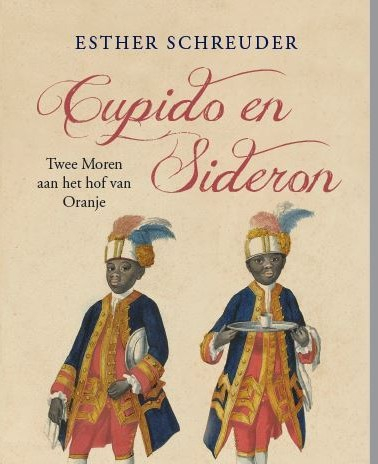Les Pêcheurs
Manufacture Royale de Gobelins, Parijs, after a design by Albert Eckhout and Frans Post (probably) collection Rijksmuseum Amsterdam
Brazil for the happy few
This tapestry, from a series of eight named. Les Anciennes tentures des Indes, became a gift from one sovereign to another.
Tapestries were exceptionally expensive to produce on account of the materials, labour and time involved. So only the very richest classes could afford them. This series, showing a new paradise decorated the palaces of Louis XIV, the palace of the Knights of Saint John on Malta, the palace of Peter the Great 1672 –1725 at Peterhof near St.-Petersburg and many other royal residences.
The tapestry, shows three Indians and an African woman with a basket of flowers. They are not ‘ethnographic portraits’ but people going about what Europeans imagined was their ‘daily business’, in a setting that seems to represent an exotic version of paradise. A number of elements in this composition are based on Albert Eckhout’s painting African woman , such as the large palm tree to the side of the scene.

While the painting shows this woman standing and looking at the viewer, on the tapestry she is seated and gazingly admiringly at the figure of a hunting Indian in a classical loincloth.
Unlike her counterpart in the painting, she does not wear European jewellery and her headgear is also different; in her basket she has flowers and plants, whereas in the painting this contains fruit.
The cartoons for the tapestries were probably drawn by Eckhout himself or the renowned tapestry weaver Maximiliaan van der Gucht 1603 –1689. Rebecca Parker Brienen suggests in Visions of Savage Paradise that Governor-General Johan Maurits van Nassau-Siegen 1606 –1679 may have informed the Dutch painters Albert Eckhout and Frans Post as early as the 1640s of his plans to have tapestries made from the artworks produced, by the two painters for him, in Brazil.
But how did Louis XIV get them?
A money problem, seems to be the key.
In 1678 Maurits van Nassau-Siegen shipped a number of drawings, some 40 paintings, cartoons, animal skins, stuffed birds and other objects to Paris.
He was in serious financial straits and hoped that Louis XIV 1638 –1715 would commission the celebrated Gobelin factory to make tapestries based on these items, for which he would be paid.
He offered this Brazilian collection to the French king as something novel and totally distinctive:
‘…on peut former une tapisserie pour meubler une grande sale ou galerie, ce qui serait une chose tres rare, qui ne se trouve plus au monde […] pouvoir ce beau pays de Bresil lequel n’a pas son parcil dans le ciel […] voyant la grande difference entre l’Europe et l’Afrique..
’he wrote in a letter to Louis’ minister Simon Arnauld de Pomponne 1618 –1699 that same year.
The ‘gift’ was accepted, but the tapestries were not made until seven years after Maurits had died.
A total of eight series were made, until the cartoons were worn out, when a new series was designed by Alexandre-Francois Desportes 1661 –1743, based on the old. The bird in flight on this tapestry could be an earlier addition by Desportes, for a similar image occurs in one of his hunting scenes
One complete series of Les Tentures des Anciennes Indes tapestries still hangs in the Maltese parliament building.
>Dutch version<
Esther Schreuder See for literature the Catalogue Black is Beautiful, Rubens to Dumas (sold out) 2008. F.i. >European High nobility dressing up as ‘Moor’, ‘Ethiopian’, African or African continent<
In 2008 I was guest curator of the exhibition Black is beautiful. Rubens to Dumas. Important advisors Elizabeth McGrath (Rubens and colleagues, Warburg institute Image of the Black in Western Art collection), Carl Haarnack (slavery in books), Elmer Kolfin (slavery in prints and paintings) en Adi Martis (contemporary art). Gary Schwartz made his research for The Image of the Black in Western Art available to me.

In 2014 my essay ‘Painted Blacks and Radical Imagery in the Netherlands (1900-1940)’ was published in The Image of the Black in Western Art Volume V (I). (ed. David Bindman, Henry Louis Gates jr.)

In 2017 I published a book about the black servants at the Court of the Royal Van Oranje family. More than a thousand documents have been found about their lives.

All photos on this site are not intended for any commercial purpose. I have tried to trace all the rules and rights of all images. As far as I know, these images can be used in this way. If you ar a copyright holder and would like a piece of your work removed or the creditline changed then please do not hesitate to contact me. estherschreuderwebsite@gmail.com






